This is a selection of one or two pictures from each day -- just a taste of the trip that I hope will inspire you to visit the detailed pages.
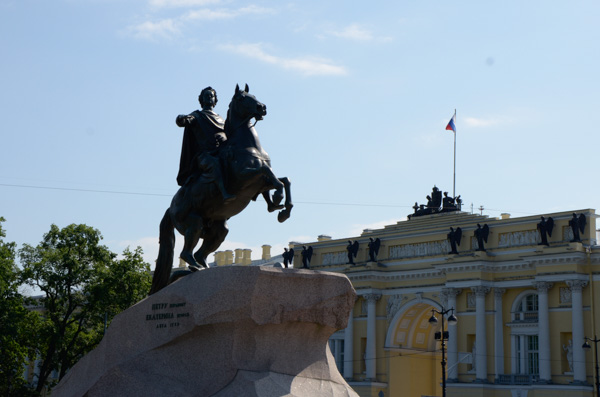
After we arrived, we spent the afternoon walking in the area of our hotel in an effort to keep awake and make progress on jetlag.
As is the case with most of our trips, we received an extensive reading list before our scheduled departure. If I learned nothing else from this trip, an introduction to Peter the Great would have sufficed. He was a remarkable man who single-handedly dragged Russia into communication with the modern (18th century) world.
This monument was erected by Catherine II (the Great) in the city that Peter founded to be the new Russian capital. The building in the background is the Senate.
Peter himself would probably have preferred being pictured with a ship rather than a horse.
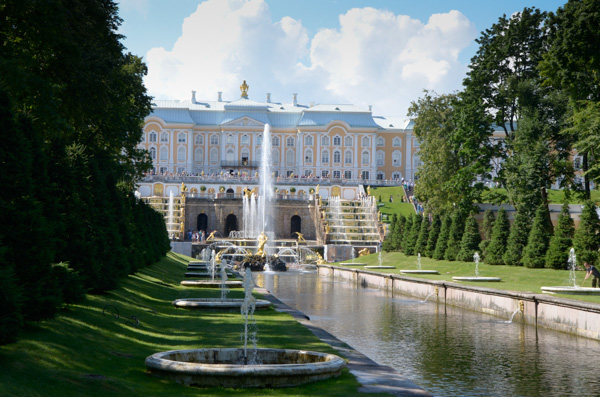
The program for our first day included a trip to Peterhof, also known as the Summer Palace. When Peter I visited Versailles, he decided that Russia needed an equivalent showplace.
This is the approach that visiting foreign dignitaries would have in Peter's day.
Most of what you see, however, is a reconstruction. The German army used the palace as a headquarters during the Siege of Leningrad. They systematically destroyed the place when they left.
Thankfully most of the art had been removed for safekeeping before their invasion and it has been returned to the rebuilt structures. The fountains and statuary were reconstructed from archival photos.
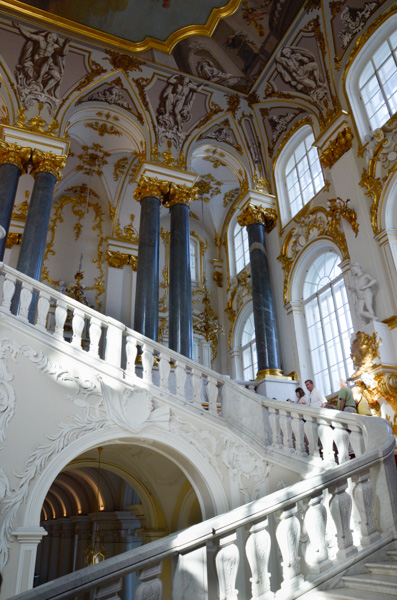
No visit to St. Petersburg would be complete without some time at the Winter Palace, the home of the Hermitage Museum.
Peter himself had built a much smaller and more modest building to use as his own town residence. It has been largely incorporated into the new palace and the area where it is located was not open during our visit. This enormous complex was constructed by his successors, the Empresses Anna & Elizabeth, and subsequently enlarged by Catherine II.
The columns shown here are constructed of lapis lazuli. It is sobering to ponder the expense of such elaborate buildings when so much of the Russian population through the ages has suffered, and continues to suffer, great poverty and repression. At least this building, and others we visited, are now open to the public. At the time they were built, they were enjoyed by very few.

Before we saw the flyer for this trip, neither of us had ever heard of Karelia. At present it is an autonomous republic within the Russian Federation, but it has a long history. Mostly it has been part of Russia (beginning in the 9th century and later) but has also been ruled at various times by the Novgorod Republic (12-15th centuries), Sweden (17th century), and Finland (early 20th century).
Our first point of interest was Kizhi, an island museum of traditional Karelian architecture and a UNESCO World Heritage Site. This is the central site, or pogost.
The left-most structure is the 18th century Church of the Transfiguration of our Savior. To its right is the 19th century bell tower. The smaller church is the 18th century Church of the Intercession.
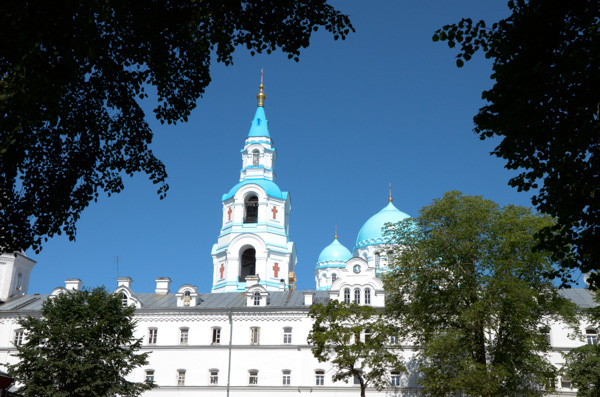
The next morning we bused to Lake Ladoga, the largest lake in Europe. There we would visit the monastery on the island of Valaam. The island has changed hands many times over the years. In 1917 it became part of an independent Finland, but in 1940 it was returned to Russian sovereignty.
The main monastery facility at Valaam was built in the 19th century. It was evacuated in 1940 with the monks taking the primary icons and relics with them to Finland where they founded "New Valaam," which still exists.
No one knows for sure when the monastery was first founded. Tradition states it was established in the 10th century, but the first reference is from the 16th century.
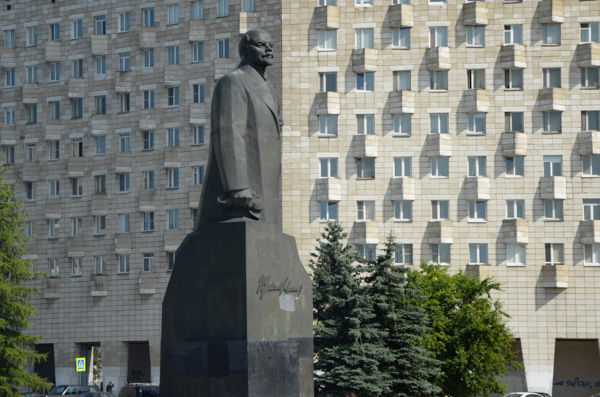
The next day we met a chartered plane bringing the main portion of our group from St. Petersburg en route to Arkhangelsk (Archangel).
After lunch we took a bus tour before meeting our ship. We saw memorials to Lenin in most urban places we visited within Russia. This one will have to stand for them all. I captured it through the bus window as we never stopped at these memorials.
For years I have thought of Lenin as a person of some (comparative) integrity in the Soviet pantheon. Based on the lectures given during this trip, however, Lenin was a pretty cynical and ruthless fellow. I may have to read up on him.
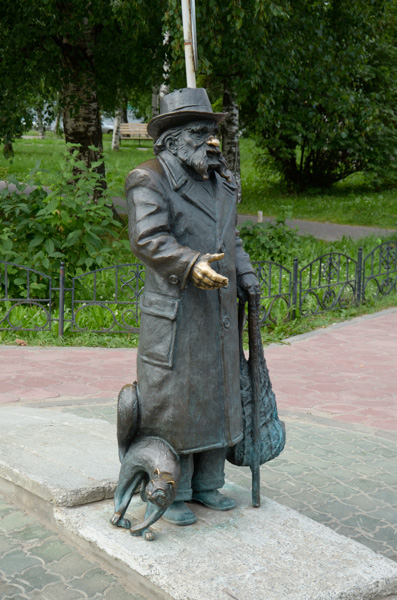
Pomorskaya Street is an open-air museum of old Arkhangelsk wooden houses. Many of the houses were moved here to preserve them. Some had been turned into restaurants and some were still used as residences. The scene included many parks and sculptures.
Stepan Pisakhov, with his drunken cat, was a local artist and story-teller. Our guide had read us one of his surreal stories on our first day's outing. It is considered good luck to shake his hand.
Our guide told us that, possibly due to the high northern location and long, dark, frozen winters, Arkhangelsk denizens have a piquant sense of humor and sense of the ridiculous.
After our morning tour we boarded the ship and departed for our circuit of the White Sea.
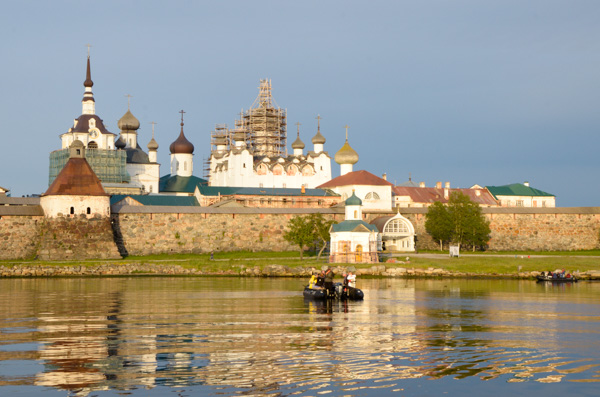
Sometimes it is Solovetskiy (or Solovetsky) and sometimes it is Solovki. Best I can tell Solovetskiy was the original name of the archipelago and monastery. Solovki came into use in the 20th century when the monastery was closed and the prison camps established. It became the prototype of the Soviet Gulag system.
We toured the monastery and island during the day.
That night after supper we had the opportunity to take the Zodiacs out to see the kremlin in the evening light. It was a magical sight.
The building on the left with the spire is the church of St. Nicholas. The building with the scaffolding covering the dome is the Transfiguration Cathedral.
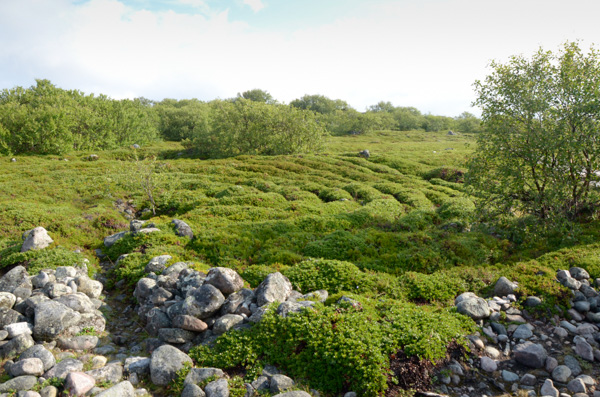
The next morning, Dr. Alexander Martynov, chief archaeologist, led us on an exploration of ancient labyrinths on neighboring Zayatsky Island. He explained the difficulties in dating these constructions and determining why they were built. The island itself is quite "new," having only risen above water since the last ice age.
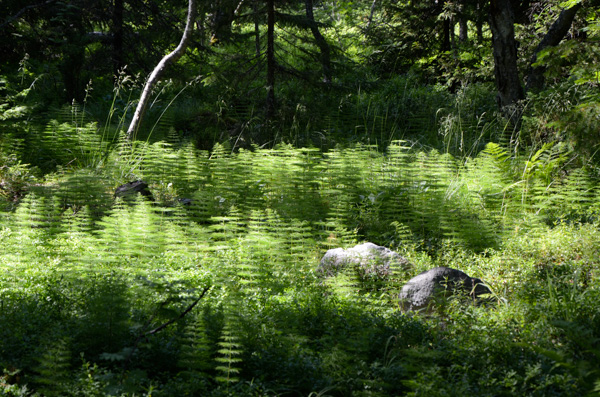
The following day we visited Anzersky Island. This is where our leaders first introduced the "long," "medium," and "leisurely" groups. In addition there was a "cruiser" group that simply cruised around the shore on Zodiacs.
I usually signed up for the long walk, which at this location was approximately seven miles with some significant elevation gain. We hiked through woods and across open tundra to reach the "world's smallest labyrinth," which was about six feet in diameter.
A distinctive feature of the undergrowth here were these ferny plants that caught the sunlight with a horizontal shimmer. They look like they are constantly in motion!

Our stop the following morning was Kuzova Island, where we visited another labyrinth.
We had a scramble to get to the top, but the views were magnificent. Zodiacs were busily shuttling folks between the island and the ship.
Of course, it was even more of a scramble getting back down!

We next headed to the less-visited northern part of Great Solovetskiy Island. There was a skete or "minor monastery" being restored.
On the way we enjoyed lunch and lectures. On most days there were lectures by the expedition staff or our Stanford faculty leader, David Holloway. For example, during our cruise between Kusova and Solovetskiy we had lectures on the geology of the White Sea and the Russian Orthodox Church. The lectures were key to the richness of the overall experience -- much more so than the information that was presented by the guides at any particular tourist spot that we visited.
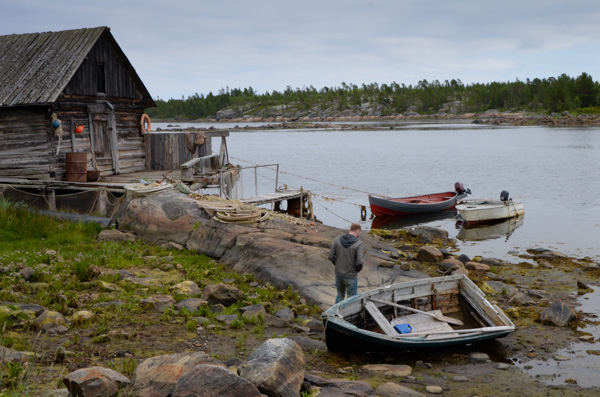
Gridino, our destination the following morning, was a prosperous fishing village as little as 30 years ago, but no more. Today the population largely consists of pensioners. The school closed years ago and the remaining children attend boarding school in the closest city, Kem.
The local fishermen were highly exercised by the appearance of our ship. They feared that we were scouting for a fishing trawler coming to poach on their fishing rights.
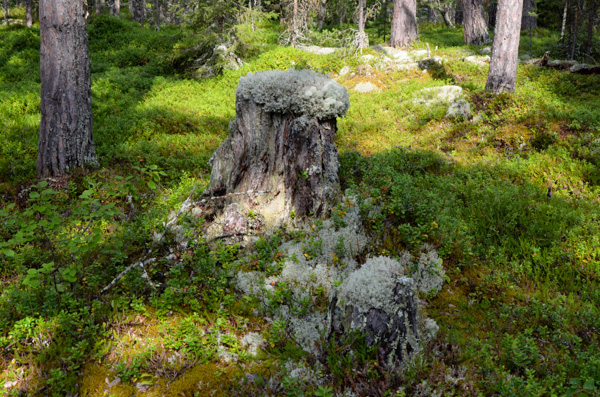
Kuzokotskiy Island is now a haven for kayakers, but it was one of the worst outposts of the gulag system This stump is a reminder of those days. Prisoners sent here faced almost certain death due to exposure and starvation. Their assignment was logging. Trees were cut with axes or handsaws and then hauled out by the men without any help of power tools or vehicles.
The stumps are grim reminders.
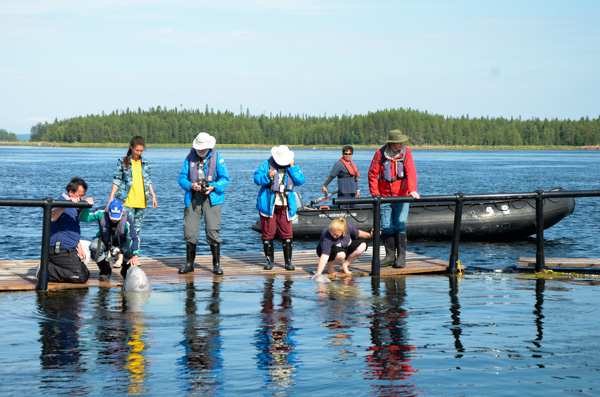
Nilmoguba Village is home to a noted ice-diving center. It has also been establishing a program with beluga whales.
There were two juvenile females in the enclosure we visited, and they were eager to "say hello."
I spoke with a young man who worked here and he said that their goal was to develop a breeding program in the nearby inlet. Whales bred in these more protected waters could then be used to restock areas where the population has declined.
At least that's what he said. There were rumors, however, that all was not as represented and that the whales kept here were destined for lives in captivity at "sea world" types of establishments.
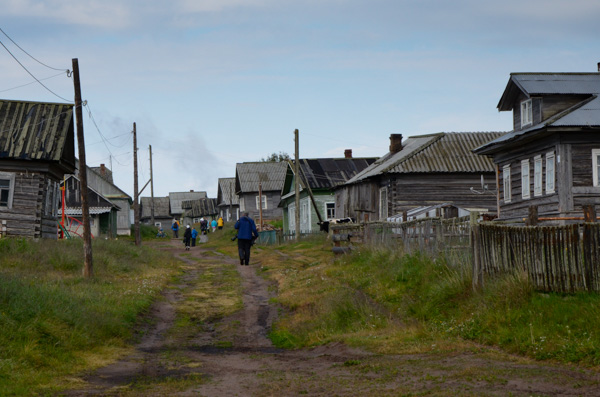
Our stop the next morning was the village of Chapoma on the Kola Peninsula. Like Gridino it was once a viable fishing community. It is now barely hanging on. There are only 30 permanent residents although others come for the summer.
This particular village does not have any roads to nearby towns. There aren't any nearby towns. The only access is via sea (in the summer - the White Sea freezes in the winter) or helicopter. Food for the single grocery is delivered monthly. We were admonished not to purchase anything because it could cause the store to run out before the next supply run.
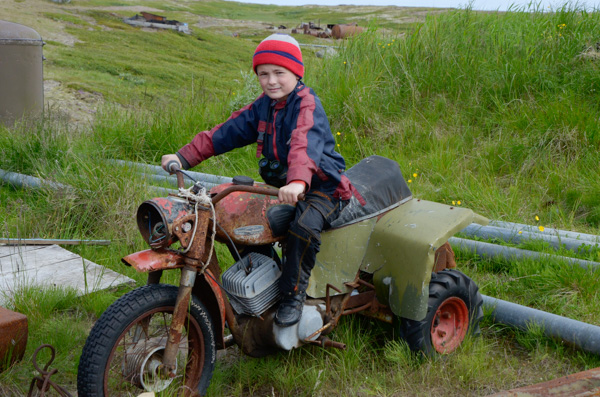
The following day we explored Morzhovets Island and its lighthouse. This barren-seeming island is home to a small contingent of support staff, a variety of birds, and an astonishing number of tiny arctic plants.
This youngster was spending the summer with his father, who is the 4th generation lighthouse keeper at this place. He spends the school year in Arkhangelsk. His dad told us that although every year he is asked if he wishes to do something else for his vacation, to date he has always wanted to come back here. Sounds like a 5th generation keeper in the wings!
I don't know if his ATV is operational or not. The tires look new, so perhaps it works in spite of the rust.

As we reached the outlet of the White Sea, we stopped at the northern cape of the Kanin peninsula. This was my favorite shore excursion of the entire trip.
The desolate-looking landscape is anything but. This one picture shows many different plants - none taller than a few inches. There are four different types of flower: white, blue and two different pinks. (The bright red appears to be leaves or bracts rather than flowers.)
Then there are what appear to be wild strawberry (purplish) and cloudberry leaves (mottled green). There is no fruit to be seen. Perhaps someone or something has already gobbled it up.
Finally there are at least five additional foliage plants including the moss.
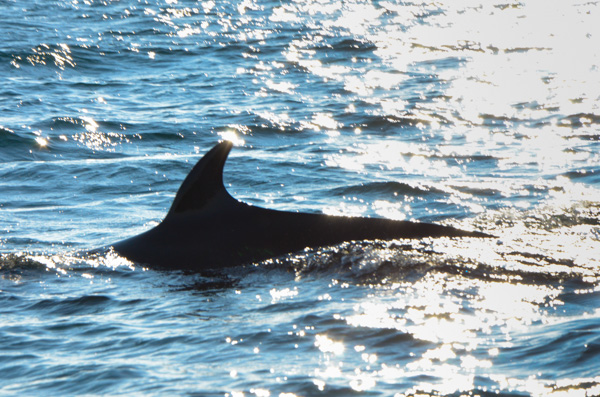 Overnight we passed from the White Sea into the Barents Sea. The morning
found us anchored among the Sem Islands Nature Preserve. We
weren't allowed to land on the islands, but we enjoyed a Zodiac
cruise to see the birds and other wildlife. A highlight was a
visit from a pair of Minke whales who gave us a thorough
investigation.
Overnight we passed from the White Sea into the Barents Sea. The morning
found us anchored among the Sem Islands Nature Preserve. We
weren't allowed to land on the islands, but we enjoyed a Zodiac
cruise to see the birds and other wildlife. A highlight was a
visit from a pair of Minke whales who gave us a thorough
investigation.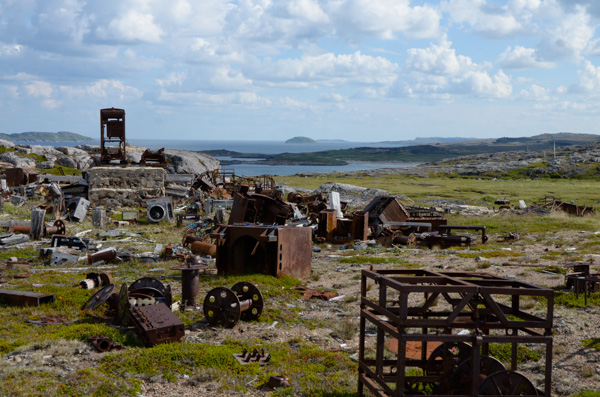
That afternoon we went ashore on the mainland to visit an abandoned Soviet-era Cold War site. It was a sobering experience, especially since we were in Russia at a time of heightening tensions reminiscent of the bad old days.
Anything that was worth anything had been taken when the station was abandoned in the 1990s. This detritus included electronic equipment that was possibly state-of-the art when the camp was created in the early 50s, but not worth the expense to remove.
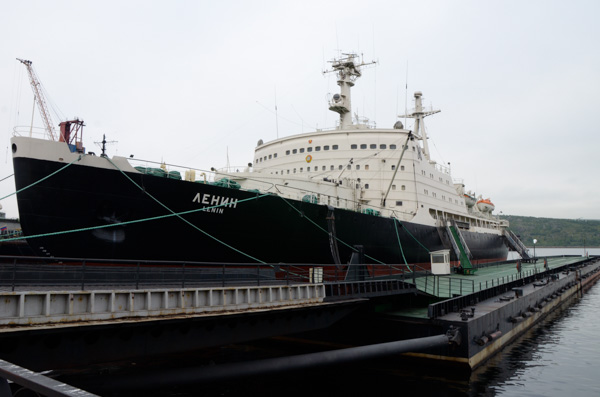
Murmansk, Russia's only ice-free European port, was to be our final stop.
Lenin was the first nuclear-powered icebreaker. These specialty ships are necessary to keep the ports open as much as possible, and the vast Arctic coast of Russia made it very difficult to supply conventional icebreakers. The development of nuclear energy was therefore a huge benefit to the country.
After the ship was retired it was turned into a museum.
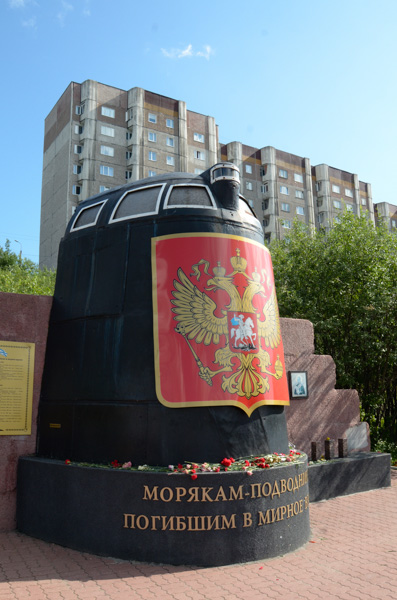
This is a monument to the 118 men who died on the submarine Kursk, sunk in 2000 by a faulty torpedo. It took the Russian government an unreasonably long time to respond to the disaster. Foreign assistance was at first rebuffed. Then the official party line was that the sub was sunk as a result of a collision with a NATO sub. Some continue to assert that it was torpedoed by a NATO ship.
In 2009 a reporter found this command tower of the submarine at a scrap metal yard. The city purchased it to create this monument.
The only consolation that can be derived is that, although some of the seamen lived for up to 6 hours after the initial disaster, there was not enough time to save them even if the rescue effort had gone as smoothly as possible.
The inscription reads: "To the submariners who died in peacetime."
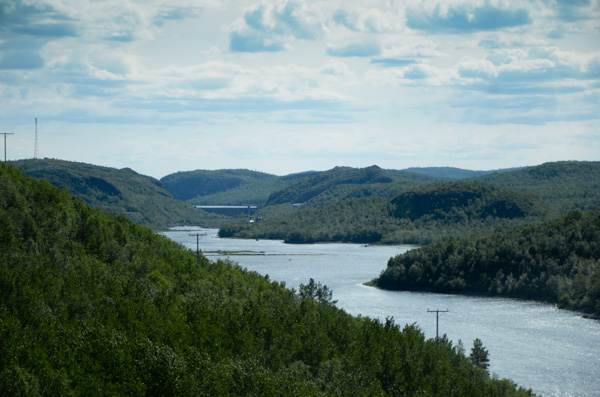
Our first stop after leaving Russia was the Norwegian town of Kirkenes, on the Norway-Russia border. We learned that residents of Kirkenes frequently drive to Russia to buy gas, because it's cheaper. Russians come to Kirkenes to buy groceries.
The border meanders along both sides of this river, which we followed on an excursion to "the beach" at Grense Jakobselv. It is easy for fishermen to get into trouble in this area if they aren't aware of where the border is, and yes, it is monitored.
Some of our number brought bathing suits along to go swimming in the Arctic. We didn't.
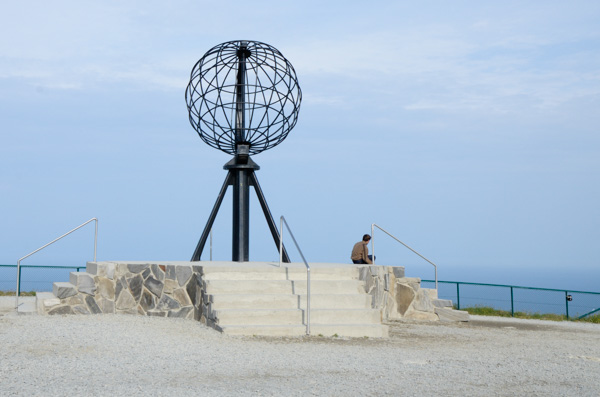
The following day's destination was Nordkapp. The monument is supposed to mark the northernmost cape of mainland Europe. Except that it isn't the mainland, it's an island. Moveover it's not the northernmost point.
But it is a dramatic headland, so why get too technical?
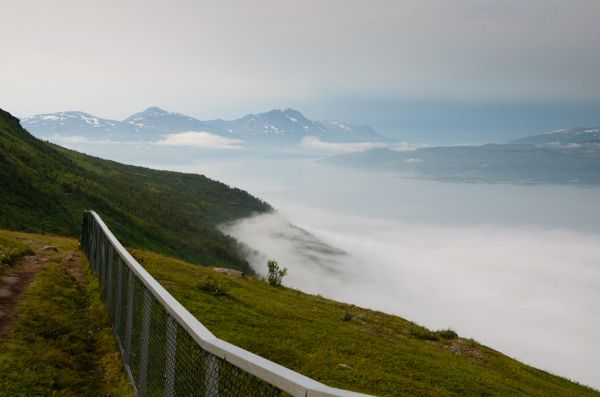
Our trip has reached its final day. Even though it was very fabulous, I can't say that we were sorry. Our bags were packed and we were ready to go. We had a morning tour of Tromsø before heading to the airport for our flight to Oslo. We would be spending the night there in the airport hotel before leaving the next morning.
Before our departure, however, we had lunch on Mount Storsteinen, where we had time to explore and view the fog lapping up the cliffs.
Click your "back" button to return to the previous page or click for our picture album.